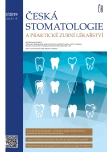The bollard bone anchored miniplates in patients with skeletal class iii malocclusion
Authors:
J. Borovec 1,2,4; P. Švihlíková Poláčková 1,3; J. Hofman 1; V. Placák 2,4; T. Petrová 1,2; W. Urbanová 1,2; M. Koťová 1,2,3
Authors‘ workplace:
Stomatologická klinika, 3. lékařská fakulta Univerzity Karlovy
a Fakultní nemocnice Královské Vinohrady, Praha
1; Stomatologická klinika, Lékařská fakulta Univerzity Karlovy a Fakultní nemocnice, Plzeň
2; Klinika zubního lékařství, Lékařská fakulta Univerzity Palackého a Fakultní nemocnice, Olomouc
3; Oddělení ústní, čelistní a obličejové chirurgie, Masarykova nemocnice v Ústí nad Labem, o. z., Krajská zdravotní, a. s., Ústí nad Labem
4
Published in:
Česká stomatologie / Praktické zubní lékařství, ročník 119, 2019, 3, s. 90-95
Category:
Original articles
Overview
Introduction and aim: The aim of this article is to introduce the method of skeletally anchored inter-jaw elastic forces in patients with skeletal class III malocclusion to the dental specialists. Skeletal class III malocclusion is an anomaly that affects 4–14% of the population in the context of anthropological specifics of different ethnic groups, with 0.48–4.0% in the Caucasian European and North American populations.
This diagnosis in children often opens many therapeutic embarrassments not only in dentist, but also in orthodontist office. If the skeletal class III malocclusion develops dynamically and, moreover, with the emphasis on the unfavorable type of growth, during the adolescence it may result in the indication of demanding jaw correction operation. This is always accompanied with a complex orthodontic preparation, necessary postoperative orthodontic treatment and a long-term retention phase. In some types of skeletal class III malocclusions, it is possible to successfully intervene during growth. Early differential diagnosis by an orthodontist or maxillofacial surgeon is essential, followed by the determination of the most effective procedure for comprehensive treatment. Except for the described method, skeletal class III malocclusions are treated using removable and fixed appliances or extraoral elastic forces at the time of growth. A goal of this early age treatment is to create and maintain an overbite of the upper frontal teeth, to expand the upper dental arch, and to control the growth tendencies of the lower jaw at the time of dental replacement.
Methods: The authors describe a surgical and orthodontic protocol for the use of skeletally anchored Bollard modified miniplates, which offers a therapeutic alternative to challenging orthognathic surgery. With a proper indication, the skeletal class III malocclusion manifestation can be significantly reduced and orthodontically compensated entirely or only partially to reduce the invasivity and extent of the necessary final orthognathic surgical intervention. The presented method offers a possibility of a growth modification of the upper jaw or of the entire stomatognathic system together with occlusion and dental arches relationship. An orthodontic part of the treatment involves adjusting the size and shape of dental arches, especially the transversal dimension of the upper dental arch. Furthermore, by applying elastic forces, the orthodontist regulates the growth of the jaws and adjusts, respectively changes their relationship. A surgical part consists of insertion of the skeletally anchored miniplates for application intermaxillary elastic forces.
Results and conclusion: The authors present the therapeutic procedure which, despite its simplicity, remains on a margin of professional interest and out of the spectrum of commonly indicated methods of choice. The therapeutic appliances, considered diagnostic criteria and orthodontic as well as surgical treatment protocol are discussed, including possible complications.
Keywords:
Bollard modified miniplates – growth modification – skeletal class III malocclusion
Sources
1. Kamínek M. Kefalometrický rtg snímek při ortodontické terapii fixními aparáty. Dokt. Dis. 1986; LF UP Olomouc.
2. Cornelis MA, Scheffler NR, De Clerck HJ, Tulloch JC, Behets CN. Systematic review of the experimental use of temporary skeletal anchorage devices in orthodontics. Am J Orthod Dentofac Orthop. 2007; 131(4): S52–S58.
3. De Clerck HJ, Cornelis MA, Cevidanes LH, Heymann GC, Tulloch CJ.Orthopedic traction of the maxilla with miniplates: a new perspective for treatment of midface deficiency. J Oral Maxillofac Surg. 2009; 67(10): 2123–2129.
4. Nguyen T, Cevidanes L, Cornelis MA, Heymann G, de Paula LK, De Clerck HJ. Three-dimensional assessment of maxillary changes associated with bone anchored maxillary protraction. Am J Orthod Dentofacial Orthop. 2011;140(6): 790–798.
5. Heymann GC, Cevidanes L, Cornelis M, De Clerck HJ, Tulloch JC. Three-dimensional analysis of maxillary protraction with intermaxillary elastics to miniplates. Am J Orthod Dentofacial Orthop. 2010; 137(2): 274–284.
6. Cornelis MA, Scheffler NR, Mahy P, Siciliano S, De Clerck HJ, Tulloch JC. Modified miniplates for temporary skeletal anchorage in orthodontics: placement and removal.surgeries. J Oral Maxillofac Surg. 2008; 66(7): 1439–1445.
7. De Clerck HJ, Cevidanes L, Baccetti T. Dentofacial effects of bone-anchored maxillary protraction: a controlled study of consecutively treated Class III patients. Am J Orthod Dentofacial Orthop. 2010;138(5): 577–581.
Labels
Maxillofacial surgery Orthodontics Dental medicineArticle was published in
Czech Dental Journal

2019 Issue 3
Most read in this issue
- The bollard bone anchored miniplates in patients with skeletal class iii malocclusion
- Comparison of histopathological and clinical prognostic factors of oral squamous cell carcinomas
- The cytocompatibility of anodized surfaces for implant materials
